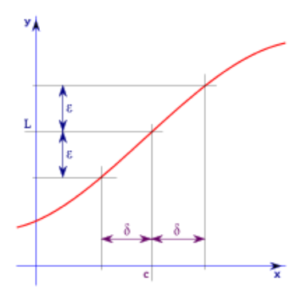Contents:
1. What is Epsilon?

In calculus, Epsilon (ε) is a tiny number, close to zero.
You’ll come across ε in proofs, especially in the “epsilon-delta” definition of a limit. The definition gives us the limit L of a function f(x) defined on a certain interval, as x approaches some number x0. For every ε > 0 there is a δ > 0 so that for every x-value:
0 <│x – x0│< δ →│f(x) – L│ < ε
If you don’t quite “get” what the formula is doing, don’t be too hard on yourself because the formula isn’t intuitive at all. Evelyn Lamb, in her Scientific American article The Subterfuge of Epsilon and Delta calls the epsilon-delta proof
“…an initiation rite into the secret society of mathematical proof writers”.
In fact, while Newton and Leibniz invented calculus in the late 1600s, it took more than 150 years to develop the rigorous δ-ε proofs. δ-ε makes its first appearance in the works of Cauchy (Grabiner, 1983):
“Let δ, ε be two very small numbers; the first is chosen so that for all numerical…values of h less than δ, and for any value of x included [in the interval of definition], the ratio (f(x + h) = f(x) ) / h will always be greater than f′(x) – ε and less than f′ (x) + ε” (Cauchy, 1823, p. 44)
Today, εδ forms the basis of just about every proof in calculus.
In Statistics
In regression analysis, epsilon (ε) is a measurement of how far from the true regression line the observation y is (e.g. in the equation, Y = Xβ + ε). The true regression line is the line of the means (the mean of epsilon is zero).
Uncommonly, you might also see the term epsilon-squared, which is a measure of effect size (a measure of relationship between groups).
2. Epsilon Calculus
ε-calculus is an extended form of predicate calculus that was developed by David Hilbert with reference to arithmetic and set theory.
ε-calculus uses an ε operator, a term-forming operator which replaces quantifiers in ordinary predicate logic (Miyamoto & Moser, 2019): For a formula A(x), εxA(x) is an ε-term.
The critical axiom in ε-calculus is TA(t) → A(εx A(x))—.
References
Cauchy, A.L. (1823). Résumé des leçons données à l’École royale polytechnique sur le calcul infinitésimal. Imprimerie royale.
Grabiner, J. (1983). Who Gave You The Epsilon? Cauchy and the Origins of Rigorous Calculus. American Mathematical Monthly 90 (1983), 185-194.
Lamb, E. (2015). The Subterfuge of ε and Delta. Retrieved September 28, 2020 from: https://blogs.scientificamerican.com/roots-of-unity/the-subterfuge-of-epsilon-and-delta/
Miyamoto, K. & Moser, G. (2019). The ε Calculus with Equality and
Herbrand Complexity. Retrieved September 28, 2020 from: http://arxiv-export-lb.library.cornell.edu/pdf/1904.11304
Slater, B. ε Calculi. Retrieved September 28, 2020 from: https://iep.utm.edu/ep-calc/